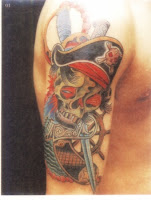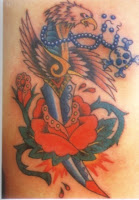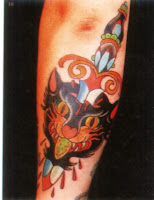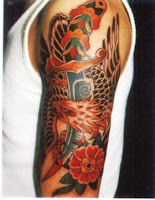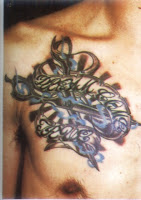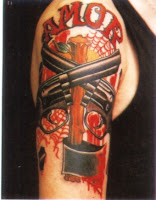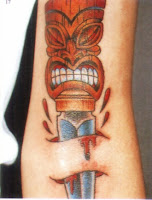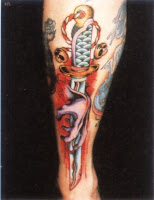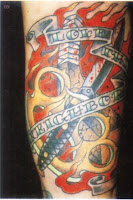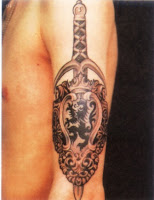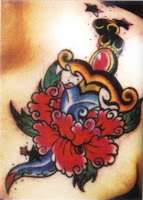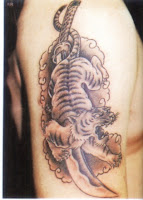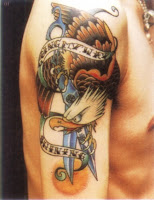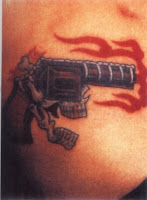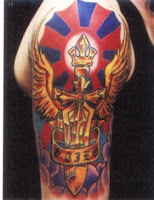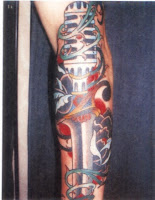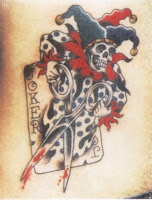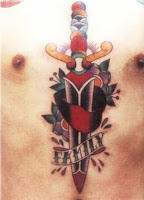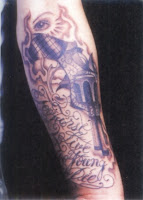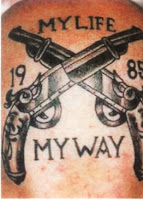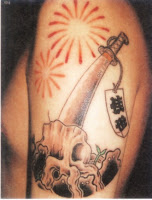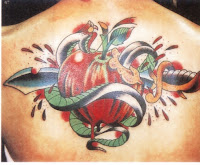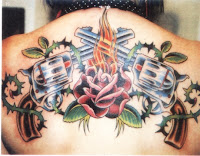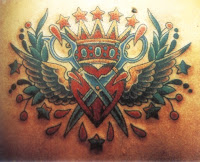TATTOO MACHINE WORK
The tattoo machine ('gun' is a misnomer) is really a basic doorbell circuit (you know--you push a button and somewhere in the kitchen this little arm bangs the hell out of a bell thingie). For you techies out there it's a DC coil and spring point(s) machine. Both doorbell and tat machine were invented before household current was available. It is essentially in 3 sections: The base, the mechanism, and the sanitary tube. The base really is the bulk of the metal; a rabbit ear with a screw in it, bent at 90 degrees to hold coils. In the front there's a round hole to hold the sanitary tube. Some people think the base looks like the handle of a gun. The base houses the mechanism, which consists of two coils of wire wrapped around an iron core.

At the top of the mechanism is a set of silver contact "points" (like the end of a wire); one usually on a spring mechanism, the other either the end, or on the end of a screw. The spring connects to the base and a bar, which is connected to the needle arm (90 degrees offset). The needle arm is connected to the needles (which are soldered onto the bar), and moves up and down inside the sanitary tube. The coils connect to a DC power supply (between 6 - 12VDC), via a spring coiled U-cable. The U-cable is called a "clip cord," designed to move easily between machines but also stay in place and not fall out and spark all over the place. The springs hold the cable in/onto the machine.
One side of the coils is connected to the power supply, the other end to the point on the screw on the bunny ear, which is insulated from the base. Through the points, the current flows via the coils and the base of the machine. This causes the coils to become electromagnetic. The electro-magnet pulls down the bar, which does two things: pulls down the needles, and opens the points. The points being open turn off the magnet. The spring assembly brings back the bar, which causes the needles to move up *AND* make contact with the points. This causes the whole cycle to happen again making the needles go up and down. Most machines have a large capacitor across the coils/points, which keeps the points from arcing and pitting, and wearing out so quickly. A capacitor is a device that holds energy kind of like a battery, but charges and discharges much faster (parts of a second rather than 3 or 4 hours).
The capacitor charges while the points are open, so when they close, the difference in voltage across them is nill. The points are really an automatic switch controlled by the spring to turn the thing off and on quickly. In old cars where there were points there was a condenser (aka capacitor) for the same reason. The sanitary tube sucks up the ink in capillary fashion, and the needles load up as long as there's ink in the small portion of the tube.It's called "sanitary" because of the cutout at the bottom of the tube, which can be rinsed out. My understanding is that there are three layers of skin: Scaly layer, epidermis, and dermis. Tattoo machines are adjusted to penetrate into the dermis layer but NOT *through* it (below it is the fat layer of the body).
When the needles go into the sanitary tube they have a layer of ink on and between them. The needles make little holes in the skin, and the ink is deposited into the holes. This is why the skin has to be stretched so blobs of ink don't stay. Otherwise, the skin will latch onto the needles, grab the ink from them and generally make a mess. Ink just put into the scaly layer would be replaced quickly and fade away. While ink into the epidermis will stay, my conjecture is that the dermis makes for more ink and perhaps a more vivid image. Machines are really of two types: Liners, and shaders. They areexactly the same, but are set up differently. The gap for a liner isaround the thickness of a dime, and a shader is the thickness of a nickel. Liner needles are usually arranged on the bar in a circular pattern. Shader needles are usually straight (like a comb), although Spaulding & Rogers sells a 15-needle round shader.
The needles are small sewing machine needles, usually made of stainless steel. Liners are in 1, 3, 4, 5, & 7-needle combinations, set in a round configuration. Note: There can really be any number of them but these seem to be most common. Shader needles are in a straight row and usually are in groups of 4, 6, 7, 9 needles. The sanitary tubes are designed especially for the combination of needles, so there's a special tube for each different number of needles in a needle bar assembly Shaders are mounted on flat needle bars while liners are mounted on round bars There are two other types of machines. Spaulding & Rogers revolution (don't know of an artist that uses this one), which is a DC motor that turns a cam that raises and lowers the needle bar assembly through a sanitary tube. The other is something that I have never seen (even in pictures) but they are used in prison and are made of tape Recorder motors, and for the life of me I don't know how they work



